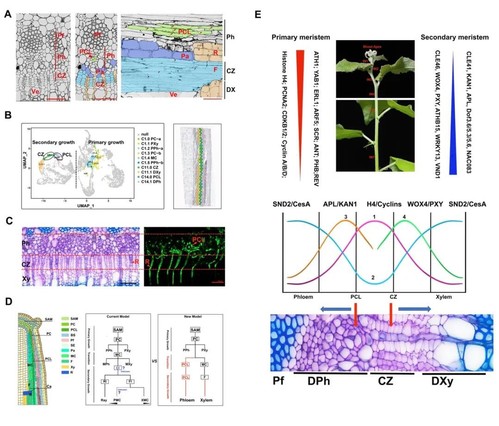Plant vascular tissue is responsible for substance transport and mechanical support within plants, and it is an important tissue type formed during the evolution of plants from aquatic to terrestrial environments. It is functionally equivalent to blood vessels and skeletal tissues in animals. Secondary vascular tissue stem cells in plants are an essential class of stem cells that have gradually evolved in perennial woody plants to adapt to various adverse terrestrial habitats such as arid conditions. They also serve as the driving force for the continuous thickening growth of plant stems. the origin, development process, cell morphology, characteristic gene expression, and stem cell activity regulation molecular mechanism of secondary vascular tissue stem cells in woody plants are yet to be explained.
Recently, Professor Ruhong Zhou participated in the study ‘High-resolution anatomical and spatial transcriptome analyses reveal two types of meristematic cell pools within the secondary vascular tissue of poplar stem’, which systematically analyzed the occurrence and development process of plant vascular tissue stem cells for the first time, through a combination of electron microscopy observation and spatial transcriptome sequencing(ST).
The authors defined features of meristematic cells in a developmental gradient from primary to secondary vascular tissues in poplar stems. The tissue-specific gene expression of meristems and derived vascular tissue types were accordingly mapped to specific anatomical domains. Pseudotime analyses were used to track the origins and changes of meristems throughout the development from primary to secondary vascular tissues. Two types of meristematic-like cell pools within secondary vascular tissues were inferred based on high-resolution microscopy combined with ST, and the results were confirmed by in situ hybridization of, transgenic trees, and single-cell sequencing. The rectangle shape procambium-like (PCL) cells develop from procambium meristematic cells and are located within the phloem domain to produce phloem cells, whereas fusiform shape cambium zone (CZ) meristematic cells develop from fusiform metacambium meristematic cells and are located inside the CZ to produce xylem cells. The gene expression atlas and transcriptional networks spanning the primary transition to secondary vascular tissues generated in this work provide new resources for studying the regulation of meristem activities and the evolution of vascular plants. The authors also established a web server (https://pgx.zju.edu.cn/stRNAPal/) to facilitate the use of ST RNA-seq data.

This pioneering research provides crucial resources for further investigating the evolution of plant vascular tissue systems. It also offers a new perspective for screening key regulatory factors in plant vascular tissue development and wood formation for molecular breeding, improving plant architecture to control plant growth, development, and stress resistance.
The work was published in Molecular Plant, and could be access at https://doi.org/10.1016/j.molp.2023.03.005
About Professor Ruhong Zhou
Ruhong Zhou, AAAS Fellow, APS Fellow, is currently Qiushi Chair Professor, Dean, College of Life Sciences; Dean, Shanghai Institute for Advanced Study; and Director, Institute of Quantitative Biology of Zhejiang University. He is also an Adjunct Professor at Department of Chemistry, Columbia University. Before that, he was a Distinguished Research Staff Scientist, and Head of the Soft Matter Science Department at IBM Research.
Professor Zhou’s research focus on Quantitative Biology; Machine Learning, Deep Learning in Biology; Biophysics; and Bio-Nano Interface (nanomedicine). He has authored and co-authored more than 300 journal publications with 25000+ total citations (Google H-index 81), filed 32 international patents and delivered 300+ invited talks at major conferences and universities worldwide. He is part of the IBM BlueGene team that won the 2009 National Medal on Technology (presented by President Obama). He has won the IBM Outstanding Technical Achievement Award (the highest technical award within IBM; 10 times), the IBM Outstanding Innovation Award (twice), and many IBM Research Division Awards. He also won the American Chemical Society DEC Award on Computational Chemistry. He was elected to AAAS Fellow (American Association of Advancement of Science) and APS Fellow (American Physical Society) in 2011. He received his PhD in Biophysical Chemistry from Columbia University, MS in Condensed Matter Physics and BS in Physics both from Zhejiang University.
About SIAS
Shanghai Institute for Advanced Study of Zhejiang University (SIAS) is a jointly launched new institution of research and development by Shanghai Municipal Government and Zhejiang University in June, 2020. The platform represents an intersection of technology and economic development, serving as a market leading trail blazer to cultivate a novel community for innovation amongst enterprises.
SIAS is seeking top talents working on the frontiers of computational sciences who can envision and actualize a research program that will bring out new solutions to areas include, but not limited to, Artificial Intelligence, Computational Biology, Computational Engineering and Fintech.

